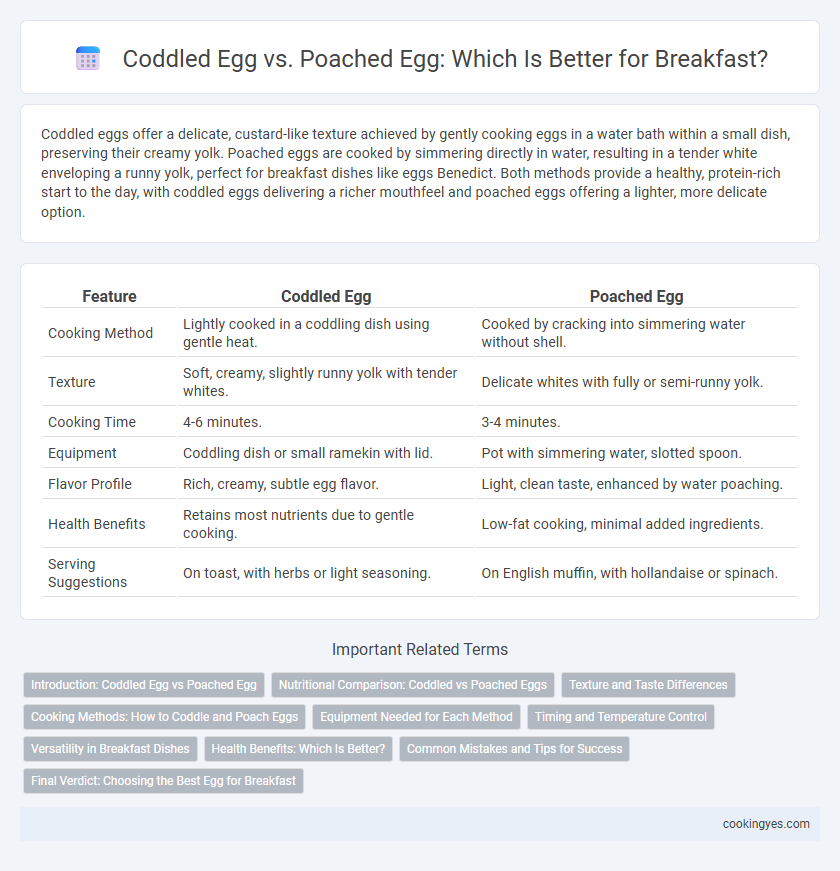Coddled eggs offer a delicate, custard-like texture achieved by gently cooking eggs in a water bath within a small dish, preserving their creamy yolk. Poached eggs are cooked by simmering directly in water, resulting in a tender white enveloping a runny yolk, perfect for breakfast dishes like eggs Benedict. Both methods provide a healthy, protein-rich start to the day, with coddled eggs delivering a richer mouthfeel and poached eggs offering a lighter, more delicate option.
Table of Comparison
| Feature | Coddled Egg | Poached Egg |
|---|---|---|
| Cooking Method | Lightly cooked in a coddling dish using gentle heat. | Cooked by cracking into simmering water without shell. |
| Texture | Soft, creamy, slightly runny yolk with tender whites. | Delicate whites with fully or semi-runny yolk. |
| Cooking Time | 4-6 minutes. | 3-4 minutes. |
| Equipment | Coddling dish or small ramekin with lid. | Pot with simmering water, slotted spoon. |
| Flavor Profile | Rich, creamy, subtle egg flavor. | Light, clean taste, enhanced by water poaching. |
| Health Benefits | Retains most nutrients due to gentle cooking. | Low-fat cooking, minimal added ingredients. |
| Serving Suggestions | On toast, with herbs or light seasoning. | On English muffin, with hollandaise or spinach. |
Introduction: Coddled Egg vs Poached Egg
Coddled eggs are gently cooked in a small container immersed in hot water, preserving a creamy texture with a tender white and runny yolk. Poached eggs are cracked directly into simmering water, producing a delicate, fully cooked white surrounding a soft, runny yolk. Both methods offer nutritious breakfast options rich in protein and vitamins, but differ in cooking technique and texture.
Nutritional Comparison: Coddled vs Poached Eggs
Coddled eggs retain more nutrients due to gentle cooking, preserving vitamins like B12 and choline, while poached eggs, cooked in boiling water, may lose slight amounts of water-soluble vitamins. Both coddled and poached eggs provide high-quality protein, healthy fats, and essential minerals, making them excellent breakfast choices. Poached eggs tend to have slightly fewer calories as they do not retain any added fats from cooking vessels, unlike coddled eggs that might include butter or cream.
Texture and Taste Differences
Coddled eggs have a soft, creamy texture due to gentle cooking in a water bath, resulting in a rich, buttery flavor with a custard-like consistency. Poached eggs feature a tender, slightly firmer white with a runny yolk, offering a delicate, fresh taste that pairs well with various breakfast dishes. The contrasting textures--silky for coddled and smooth yet structured for poached--affect the overall eating experience and complement different meal preparations.
Cooking Methods: How to Coddle and Poach Eggs
Coddled eggs are gently cooked by placing them in a small jar or coddler and immersing it in simmering water, allowing the heat to slowly cook the egg while maintaining a soft texture. Poached eggs are prepared by cracking fresh eggs directly into simmering water, usually with a splash of vinegar, and cooking them until the white is set but the yolk remains runny. Both methods require precise temperature control and timing to achieve the ideal creamy consistency prized in breakfast dishes.
Equipment Needed for Each Method
Coddled eggs require a coddler, a small porcelain or metal cup with a lid, which allows gentle cooking in boiling water while maintaining the egg's shape. Poached eggs need a shallow pan filled with simmering water, often enhanced by adding vinegar to help coagulate the egg whites quickly, and sometimes a slotted spoon is essential for removing the delicate eggs. Both methods demand minimal specialized equipment but differ in their tool requirements, impacting ease and presentation for breakfast preparation.
Timing and Temperature Control
Coddled eggs cook gently in a water bath at around 70-80degC, requiring 4-6 minutes for a soft, creamy texture, allowing precise temperature control. Poached eggs are cooked directly in simmering water at 80-90degC for 2-4 minutes, necessitating careful timing to achieve a firm white and runny yolk. Both methods demand specific temperature and timing to optimize texture and flavor for breakfast.
Versatility in Breakfast Dishes
Coddled eggs offer a creamy texture that enhances dishes like soft egg salads and delicate breakfast casseroles, while poached eggs provide a runny yolk that perfectly complements toast, avocado, and shakshuka. Both methods support diverse meal options, with coddled eggs suited for gentle flavors and poached eggs excelling in robust, savory preparations. The choice between coddled and poached eggs depends on desired texture and how the egg integrates with other breakfast ingredients.
Health Benefits: Which Is Better?
Coddled eggs retain more nutrients due to gentle cooking in a water bath, preserving vitamins like B12 and choline effectively. Poached eggs, cooked without added fats, offer lower calorie content and reduced cholesterol oxidation, benefiting heart health. Both methods provide high-quality protein and essential amino acids, but poached eggs are often favored for their lower fat and calorie content, making them a healthier breakfast option.
Common Mistakes and Tips for Success
Common mistakes when preparing coddled eggs include overheating, which causes a rubbery texture, and undercooking, resulting in a runny white. For poached eggs, preventing the whites from dispersing often fails due to not using fresh eggs or skipping the vinegar in the water. To ensure success, maintain water temperature around 75-80degC for coddled eggs and gently swirl simmering water with added vinegar when poaching to keep the whites intact.
Final Verdict: Choosing the Best Egg for Breakfast
Coddled eggs offer a creamy texture with a gentle cooking method that preserves delicate flavors, ideal for those who enjoy a soft, custard-like yolk. Poached eggs provide a firmer white and runny yolk, delivering a classic breakfast experience with fewer calories due to minimal added fat. For a nutritious start, poached eggs are the best choice, while coddled eggs suit those seeking a richer, more indulgent alternative.
Coddled egg vs Poached egg for breakfast Infographic

 cookingyes.com
cookingyes.com